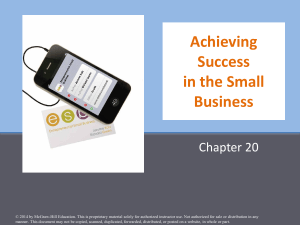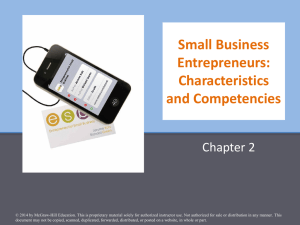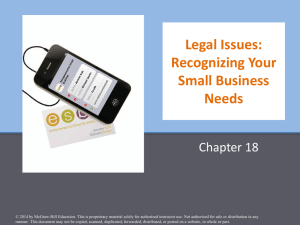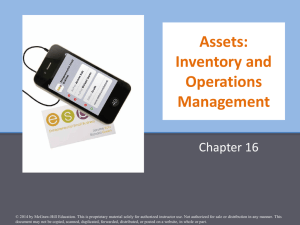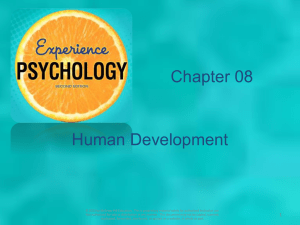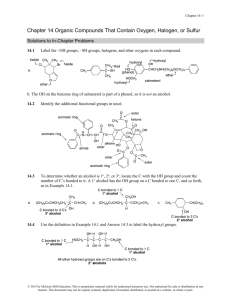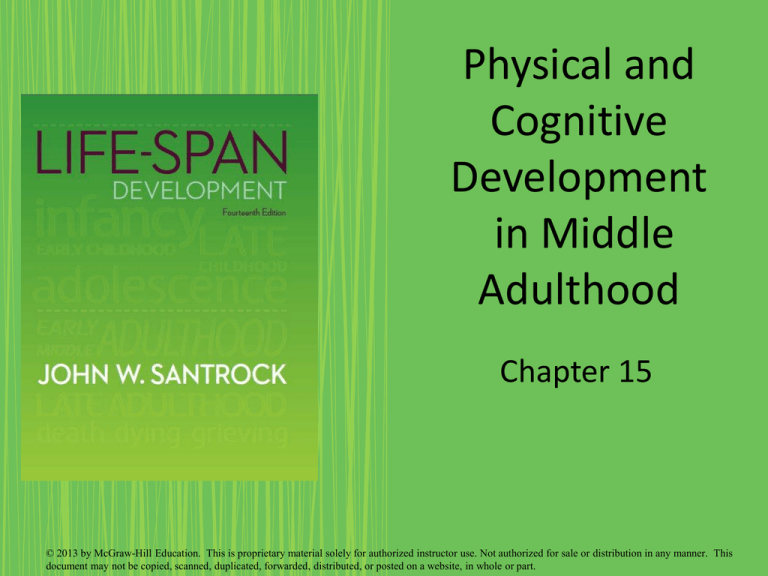
Physical and
Cognitive
Development
in Middle
Adulthood
Chapter 15
© 2013 by McGraw-Hill Education. This is proprietary material solely for authorized instructor use. Not authorized for sale or distribution in any manner. This
document may not be copied, scanned, duplicated, forwarded, distributed, or posted on a website, in whole or part.
Chapter Outline
•
•
•
•
•
The nature of middle adulthood
Physical development
Cognitive development
Careers, work, and leisure
Religion, spirituality, and meaning in life
15 - 2
© 2013 by McGraw-Hill Education. This is proprietary material solely for authorized instructor use. Not authorized for sale or distribution in any manner. This
document may not be copied, scanned, duplicated, forwarded, distributed, or posted on a website, in whole or part.
The Nature of Middle Adulthood
• Changing midlife
– As adults become older, their age identity is
younger than their chronological age
– An increasing percentage of the population is
made up of middle-aged and older adults
• “Rectangularization” of the age distribution
15 - 3
© 2013 by McGraw-Hill Education. This is proprietary material solely for authorized instructor use. Not authorized for sale or distribution in any manner. This
document may not be copied, scanned, duplicated, forwarded, distributed, or posted on a website, in whole or part.
The Nature of Middle Adulthood
• Defining middle adulthood
– Middle adulthood: 40–45 years of age to about
60–65 years of age
– Declining physical skills and increasing
responsibility
– Awareness of the young-old polarity
– Transmitting something meaningful to the next
generation
– Reaching and maintaining career satisfaction
15 - 4
© 2013 by McGraw-Hill Education. This is proprietary material solely for authorized instructor use. Not authorized for sale or distribution in any manner. This
document may not be copied, scanned, duplicated, forwarded, distributed, or posted on a website, in whole or part.
The Nature of Middle Adulthood
• Defining middle adulthood
– Gains and losses and biological and sociocultural
factors balance each other
– Late midlife (55 to 65) is likely to be characterized
by:
•
•
•
•
Death of a parent
Last child leaving the parental home
Becoming a grandparent
Preparation for and actual retirement
15 - 5
© 2013 by McGraw-Hill Education. This is proprietary material solely for authorized instructor use. Not authorized for sale or distribution in any manner. This
document may not be copied, scanned, duplicated, forwarded, distributed, or posted on a website, in whole or part.
Physical Development
• Physical changes
– Visible signs
•
•
•
•
•
Wrinkling and sagging of skin
Appearance of aging spots
Hair becomes thinner and grayer
Nails become thicker and more brittle
Yellowing of teeth
15 - 6
© 2013 by McGraw-Hill Education. This is proprietary material solely for authorized instructor use. Not authorized for sale or distribution in any manner. This
document may not be copied, scanned, duplicated, forwarded, distributed, or posted on a website, in whole or part.
Physical Development
• Physical changes
– Height and weight
• Individuals lose height and gain weight
• Being overweight is a critical health problem in middle
adulthood
15 - 7
© 2013 by McGraw-Hill Education. This is proprietary material solely for authorized instructor use. Not authorized for sale or distribution in any manner. This
document may not be copied, scanned, duplicated, forwarded, distributed, or posted on a website, in whole or part.
Physical Development
• Physical changes
– Strength, joints, and bones
• Sarcopenia - Age-related loss of muscle mass and
strength
• Cushions for bone movement become less efficient
– Leading to joint stiffness and more difficulty in movement
• Progressive bone loss
15 - 8
© 2013 by McGraw-Hill Education. This is proprietary material solely for authorized instructor use. Not authorized for sale or distribution in any manner. This
document may not be copied, scanned, duplicated, forwarded, distributed, or posted on a website, in whole or part.
Physical Development
• Physical changes
– Vision and hearing
• Accommodation of the eye - Ability to focus and
maintain an image on the retina
– Experiences sharp declines between 40–59 years
•
•
•
•
Difficulty viewing close objects
Reduced blood supply decreases visual field
Hearing can start to decline by the age of 40
High-pitched sounds are typically lost first
15 - 9
© 2013 by McGraw-Hill Education. This is proprietary material solely for authorized instructor use. Not authorized for sale or distribution in any manner. This
document may not be copied, scanned, duplicated, forwarded, distributed, or posted on a website, in whole or part.
Physical Development
• Physical changes
– Cardiovascular system
• High blood pressure, high cholesterol, and
cardiovascular disease
• Metabolic syndrome: Hypertension, obesity, and
insulin resistance
• Exercise, weight control, and a diet rich in fruits,
vegetables, and whole grains can often help
15 - 10
© 2013 by McGraw-Hill Education. This is proprietary material solely for authorized instructor use. Not authorized for sale or distribution in any manner. This
document may not be copied, scanned, duplicated, forwarded, distributed, or posted on a website, in whole or part.
Physical Development
• Physical changes
– Lungs
• Lung tissue becomes less elastic at about age 55,
decreasing the lung’s capacity
– Sleep
• Wakeful periods become more frequent in the 40’s
• Sleep-disordered breathing and restless legs syndrome
15 - 11
© 2013 by McGraw-Hill Education. This is proprietary material solely for authorized instructor use. Not authorized for sale or distribution in any manner. This
document may not be copied, scanned, duplicated, forwarded, distributed, or posted on a website, in whole or part.
Physical Development
• Health, disease, stress, and control
– Chronic disorders: Slow onset and a long duration
• Rare in early adulthood but increase in middle age
– Stress and disease
• The immune system and stress
• Stress and the cardiovascular system
• Culture and health
– Control
• Peaks in midlife then declines in late adulthood
15 - 12
© 2013 by McGraw-Hill Education. This is proprietary material solely for authorized instructor use. Not authorized for sale or distribution in any manner. This
document may not be copied, scanned, duplicated, forwarded, distributed, or posted on a website, in whole or part.
Physical Development
• Mortality rates
– Chronic diseases are the main cause of death
during middle adulthood
• Heart disease
• Cancer
15 - 13
© 2013 by McGraw-Hill Education. This is proprietary material solely for authorized instructor use. Not authorized for sale or distribution in any manner. This
document may not be copied, scanned, duplicated, forwarded, distributed, or posted on a website, in whole or part.
Physical Development
• Sexuality
– Climacteric: Midlife transition in which fertility
declines
– Menopause: Cessation of a woman’s menstrual
periods
• During the late forties or early fifties
– Perimenopause - Transitional period from normal
menstrual periods to no menstrual periods at all
15 - 14
© 2013 by McGraw-Hill Education. This is proprietary material solely for authorized instructor use. Not authorized for sale or distribution in any manner. This
document may not be copied, scanned, duplicated, forwarded, distributed, or posted on a website, in whole or part.
Physical Development
• Sexuality
– Menopause
• Hot flashes, nausea, fatigue, and rapid heartbeat
– Hormone replacement therapy (HRT)
15 - 15
© 2013 by McGraw-Hill Education. This is proprietary material solely for authorized instructor use. Not authorized for sale or distribution in any manner. This
document may not be copied, scanned, duplicated, forwarded, distributed, or posted on a website, in whole or part.
Physical Development
• Sexuality
– Hormonal changes in middle-aged men
• Decline in sexual hormone level and activity
• Erectile dysfunction: Inability to achieve and maintain
an erection
15 - 16
© 2013 by McGraw-Hill Education. This is proprietary material solely for authorized instructor use. Not authorized for sale or distribution in any manner. This
document may not be copied, scanned, duplicated, forwarded, distributed, or posted on a website, in whole or part.
Physical Development
– Sexual attitudes and behavior
• Sexual activity occurs less frequently than in early
adulthood
– Middle-aged men are more interested in sex than middleaged women
• Living with a spouse or partner makes all the difference
in terms of engaging in sexual activity
15 - 17
© 2013 by McGraw-Hill Education. This is proprietary material solely for authorized instructor use. Not authorized for sale or distribution in any manner. This
document may not be copied, scanned, duplicated, forwarded, distributed, or posted on a website, in whole or part.
Figure 15.2 - The Sex in America Survey: Frequency
of Sex at Different Points in Adult Development
15 - 18
© 2013 by McGraw-Hill Education. This is proprietary material solely for authorized instructor use. Not authorized for sale or distribution in any manner. This
document may not be copied, scanned, duplicated, forwarded, distributed, or posted on a website, in whole or part.
Cognitive Development
• Intelligence
– Crystallized intelligence: Accumulated
information and verbal skills
• Continues to increase in middle adulthood
– Fluid intelligence: Ability to reason abstractly
• May begin to decline in middle adulthood
15 - 19
© 2013 by McGraw-Hill Education. This is proprietary material solely for authorized instructor use. Not authorized for sale or distribution in any manner. This
document may not be copied, scanned, duplicated, forwarded, distributed, or posted on a website, in whole or part.
Figure 15.3 - Fluid and Crystallized Intellectual
Development Across the Life Span
15 - 20
© 2013 by McGraw-Hill Education. This is proprietary material solely for authorized instructor use. Not authorized for sale or distribution in any manner. This
document may not be copied, scanned, duplicated, forwarded, distributed, or posted on a website, in whole or part.
Cognitive Development
• Intelligence
– The Seattle Longitudinal Study - Extensive
evaluation of intellectual abilities during
adulthood
– Classified participants as:
• Decliners, stable and gainers for:
– Number ability, delayed recall , and word fluency
15 - 21
© 2013 by McGraw-Hill Education. This is proprietary material solely for authorized instructor use. Not authorized for sale or distribution in any manner. This
document may not be copied, scanned, duplicated, forwarded, distributed, or posted on a website, in whole or part.
Figure 15.4 - Longitudinal Changes in Six Intellectual
Abilities from Age 25 to age 95
15 - 22
© 2013 by McGraw-Hill Education. This is proprietary material solely for authorized instructor use. Not authorized for sale or distribution in any manner. This
document may not be copied, scanned, duplicated, forwarded, distributed, or posted on a website, in whole or part.
Figure 15.5 - Cross-Sectional and Longitudinal Comparisons
of Intellectual Change in Middle Adulthood
15 - 23
© 2013 by McGraw-Hill Education. This is proprietary material solely for authorized instructor use. Not authorized for sale or distribution in any manner. This
document may not be copied, scanned, duplicated, forwarded, distributed, or posted on a website, in whole or part.
Cognitive Development
• Information processing
– Speed of information processing
• Reaction-time task
• Causes for the decline in speed
–
–
–
–
Levels of analysis
Cognitive
Neuroanatomical
Neurochemical
15 - 24
© 2013 by McGraw-Hill Education. This is proprietary material solely for authorized instructor use. Not authorized for sale or distribution in any manner. This
document may not be copied, scanned, duplicated, forwarded, distributed, or posted on a website, in whole or part.
Cognitive Development
– Memory
• Verbal memory declines during middle adulthood
• Linked to changes in working memory and ineffective
memory strategies
15 - 25
© 2013 by McGraw-Hill Education. This is proprietary material solely for authorized instructor use. Not authorized for sale or distribution in any manner. This
document may not be copied, scanned, duplicated, forwarded, distributed, or posted on a website, in whole or part.
Cognitive Development
• Information processing
– Expertise
• Rely on accumulated experience
• Process information automatically and analyze it more
efficiently
• Have better strategies and shortcuts to solving
problems
• Are more creative and flexible in solving problems
– Practical problem solving
15 - 26
© 2013 by McGraw-Hill Education. This is proprietary material solely for authorized instructor use. Not authorized for sale or distribution in any manner. This
document may not be copied, scanned, duplicated, forwarded, distributed, or posted on a website, in whole or part.
Careers, Work, and Leisure
• Work in midlife
– The role of work is central during middle age
– In the U.S., about 80% of people aged 40-59 years
of age are employed
– A time of evaluation, assessment, and reflection
about work
15 - 27
© 2013 by McGraw-Hill Education. This is proprietary material solely for authorized instructor use. Not authorized for sale or distribution in any manner. This
document may not be copied, scanned, duplicated, forwarded, distributed, or posted on a website, in whole or part.
Careers, Work, and Leisure
• Career challenges and changes
– Challenges
•
•
•
•
•
Globalization of work
Rapid developments in information technologies
Downsizing organizations
Early retirement
Pensions and health care
– Changes
• Self-motivated
• Consequence of losing one’s job
15 - 28
© 2013 by McGraw-Hill Education. This is proprietary material solely for authorized instructor use. Not authorized for sale or distribution in any manner. This
document may not be copied, scanned, duplicated, forwarded, distributed, or posted on a website, in whole or part.
Careers, Work, and Leisure
• Leisure
– Pleasant times after work
• When individuals are free to pursue activities and
interests of their own choosing
– Changes may produce expanded opportunities for
leisure
15 - 29
© 2013 by McGraw-Hill Education. This is proprietary material solely for authorized instructor use. Not authorized for sale or distribution in any manner. This
document may not be copied, scanned, duplicated, forwarded, distributed, or posted on a website, in whole or part.
Religion, Spirituality, and Meaning
in Life
• Religion, spirituality, and adult lives
– Religion: Organized set of beliefs, practices,
rituals, and symbols:
• Increases an individual’s connection to a sacred or
transcendent other
– Religiousness: Degree to which an individual is
affiliated with an organized religion
• Participates in prescribed rituals and practices
• Feels a sense of connection with its beliefs
• Involved in a community of believers
15 - 30
© 2013 by McGraw-Hill Education. This is proprietary material solely for authorized instructor use. Not authorized for sale or distribution in any manner. This
document may not be copied, scanned, duplicated, forwarded, distributed, or posted on a website, in whole or part.
Religion, Spirituality, and Meaning
in Life
• Religion, spirituality, and adult lives
– Spirituality: Experiencing something beyond
oneself in a transcendent manner
• Living in a way that benefits others and society
15 - 31
© 2013 by McGraw-Hill Education. This is proprietary material solely for authorized instructor use. Not authorized for sale or distribution in any manner. This
document may not be copied, scanned, duplicated, forwarded, distributed, or posted on a website, in whole or part.
Figure 15.6 - Level of Spirituality in Four
Adult Age Periods
15 - 32
© 2013 by McGraw-Hill Education. This is proprietary material solely for authorized instructor use. Not authorized for sale or distribution in any manner. This
document may not be copied, scanned, duplicated, forwarded, distributed, or posted on a website, in whole or part.
Religion and Meaning in Life
• Religion, spirituality and health
– Religion is positively linked to health
– Religious commitment helps to:
• Moderate blood pressure and hypertension
15 - 33
© 2013 by McGraw-Hill Education. This is proprietary material solely for authorized instructor use. Not authorized for sale or distribution in any manner. This
document may not be copied, scanned, duplicated, forwarded, distributed, or posted on a website, in whole or part.
Religion and Meaning in Life
• Meaning in life
– Emphasized each person’s uniqueness and the
finiteness of life
– According to Frankl, the three most distinct
human qualities are:
• Spirituality
• Freedom
• Responsibility
15 - 34
© 2013 by McGraw-Hill Education. This is proprietary material solely for authorized instructor use. Not authorized for sale or distribution in any manner. This
document may not be copied, scanned, duplicated, forwarded, distributed, or posted on a website, in whole or part.
Religion and Meaning in Life
– According to Roy Baumeister and Kathleen Vohs
the four main needs are:
•
•
•
•
Need for purpose
Need for values
Need for a sense of efficacy
Need for self-worth
15 - 35
© 2013 by McGraw-Hill Education. This is proprietary material solely for authorized instructor use. Not authorized for sale or distribution in any manner. This
document may not be copied, scanned, duplicated, forwarded, distributed, or posted on a website, in whole or part.


